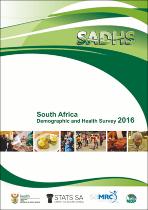| dc.contributor.author | Roomaney, Rifqah Abeeda | |
| dc.contributor.author | van Wyk, Brian | |
| dc.contributor.author | Cois, Annibale | |
| dc.contributor.author | Pillay van-Wyk, Victoria | |
| dc.date.accessioned | 2023-02-07T07:13:18Z | |
| dc.date.available | 2023-02-07T07:13:18Z | |
| dc.date.issued | 2023 | |
| dc.identifier.citation | Roomaney, R. A., van Wyk, B., Cois, A., & Pillay van-Wyk, V. (2023). Multimorbidity patterns in south africa: A latent class analysis. Frontiers in Public Health, 10 doi:10.3389/fpubh.2022.1082587 | en_US |
| dc.identifier.uri | https//doi.org/:10.3389/fpubh.2022.1082587 | |
| dc.identifier.uri | http://hdl.handle.net/10566/8363 | |
| dc.description.abstract | Introduction: South Africa has the largest burden of HIV worldwide and has a growing burden of non-communicable diseases; the combination of which may lead to diseases clustering in ways that are not seen in other regions. This study sought to identify common disease classes and sociodemographic and lifestyle factors associated with each disease class. Methods: Data were analyzed from the South African Demographic and Health Survey 2016. A latent class analysis (LCA) was conducted using nine disease conditions. Sociodemographic and behavioral factors associated with each disease cluster were explored. All analysis was conducted in Stata 15 and the LCA Stata plugin was used to conduct the latent class and regression analysis. Results: Multimorbid participants were included (n = 2 368). Four disease classes were identified: (1) HIV, Hypertension and Anemia (comprising 39.4% of the multimorbid population), (2) Anemia and Hypertension (23.7%), (3) Cardiovascular-related (19.9%) and (4) Diabetes and Hypertension (17.0%). Age, sex, and lifestyle risk factors were associated with class membership. In terms of age, with older adults were less likely to belong to the first class (HIV, Hypertension and Anemia). Males were more likely to belong to Class 2 (Anemia and Hypertension) and Class 4 (Diabetes and Hypertension). In terms of alcohol consumption, those that consumed alcohol were less likely to belong to Class 4 (Diabetes and Hypertension). Current smokers were more likely to belong to Class 3 (Cardiovascular-related). People with a higher body mass index tended to belong to Class 3 (Cardiovascular-related) or the Class 4 (Diabetes and Hypertension). Conclusion: This study affirmed that integrated care is urgently needed, evidenced by the largest disease class being an overlap of chronic infectious diseases and non-communicable diseases. This study also highlighted the need for hypertension to be addressed. Tackling the risk factors associated with hypertension could avert an epidemic of multimorbidity. | en_US |
| dc.language.iso | en | en_US |
| dc.publisher | Frontiers Media S.A. | en_US |
| dc.subject | Disease clusters | en_US |
| dc.subject | Prevalence | en_US |
| dc.subject | Multimorbidity | en_US |
| dc.subject | Latent class analysis | en_US |
| dc.title | Multimorbidity patterns in South Africa: A latent class analysis | en_US |
| dc.type | Article | en_US |

